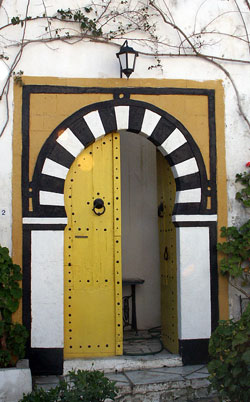About the Ennejma Ezzahra Palace
Discover the palace and its museum
The heavy wooden door leaves, painted yellow and studded with black tacks in the Andalusian fashion, open onto a path that skirts around the hill at the foot of the village, which one doesn’t have the occasion to make out because of the rapid slope; the path finally widens and fills out in front of a palace so as to get full sight of it: Ennejma Ezzahra.
Much bigger, much more elongated than the other houses of the village, it is covered by a terrace just like the other houses. Just like the other houses, it remains hermetic, jealous of its secret, pierced only by some windows of different shapes. The man who built this place knew the value of a wall, a bare wall, without any sculpture, without any moldings, without any display of vain know-how, and, standing out against these dazzling surfaces, there is the charming accident of a blue-green painted mashrabiya under a canopy of glazed pantiles or of wrought-iron bars refusing the access to a window.
In this massive whole, only the portico on the ground floor stands out: it rests on fine marble columns, which air and lighten the cube of the building while at the same time creating a delicate rampart of shade and coolness between the inside and the outside.
Inside, the same awareness of Arabic-Andalusian subtleties of comfort is added to the original type of Greco-Roman villa under a more blazing sky; but the shade is deeper in the height of summer, the water flows through small channels with a cool murmur; furniture is scarce, some of the rarest Persian carpets cover the floor ; on the walls, from bottom to top, one can see the division in three parts that is an ornamental rule in the entire Orient : a marble covering of mosaics or ceramic tiles, a frieze of stucco in openwork with bias intaglio engravings for the light of day to constantly search through, and lastly a gilded ceiling of sculpted cedar wood, still keeping its aromatic scent.
Every where one feels the presence of a man who hasn’t the boldness to claim nature’s placebut who - having discovered one of the most breathtaking landscapes in the world and wanting to express the emotion which this view stirs in him – arranges, in gardens, pauses in the appropriate places and extends lines, adding to or removing from reality the little something that is almost always lacking or “too much”.
Ennejma Ezzahra meets my eyes as a paradoxical achievement, a miraculous equilibrium between landscape and architecture, between nature and the human faculty to add something to nature.
Excerpt from the book by LéandreVaillat (a friend of the Baron) entitled "Le Collier de Jasmin" (The Jasmine Necklace), published in 1946 by the "Editions l’Artisan".
